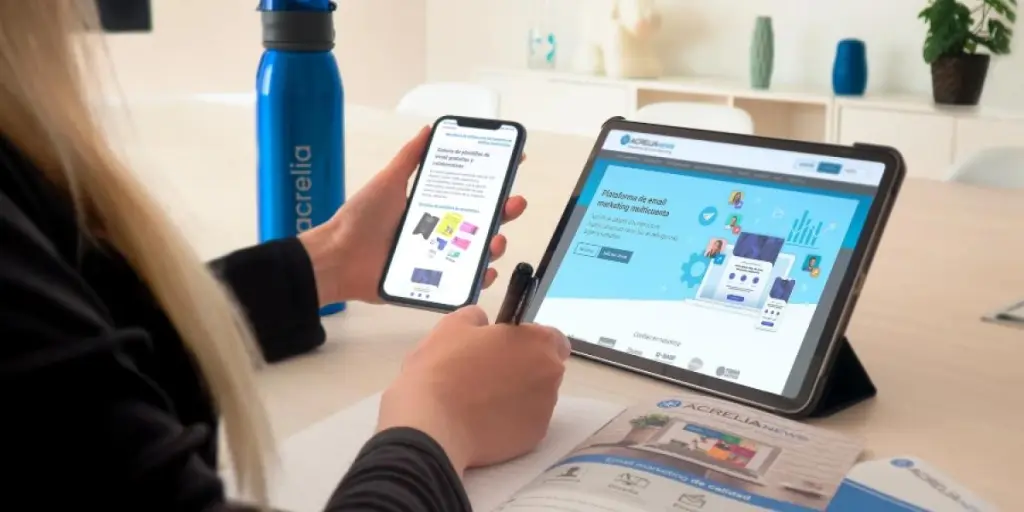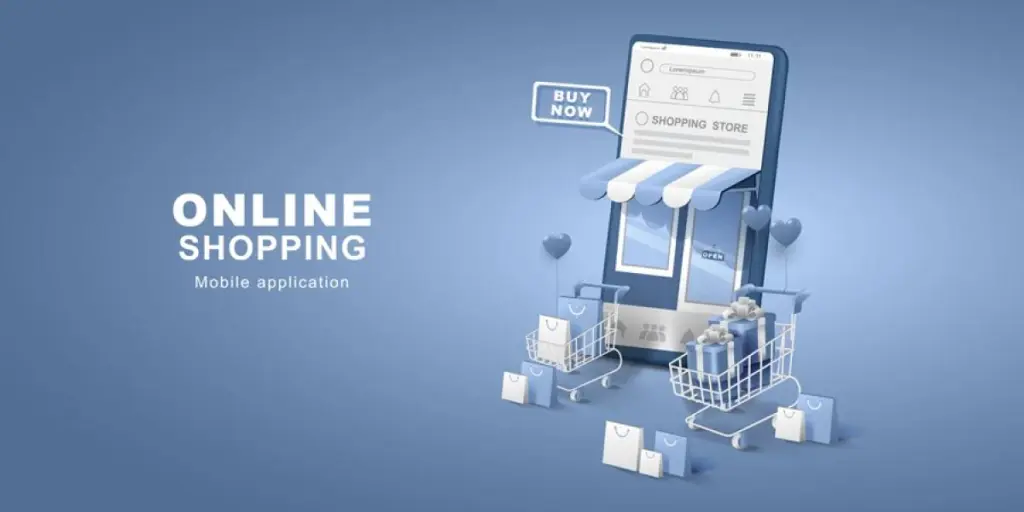Your customer engagement marketing strategy has one goal — to engage customers in meaningful conversations about your brand. But how do you make sure that you’re taking the right steps?
Building customer relationships is key for any successful business. It helps you create loyalty, foster trust, and increase customer retention. That’s why it’s so important to have a comprehensive customer engagement marketing plan in place.
In this guide, we’ll take a look at how you can create an effective customer engagement marketing strategy.
Table of Contents
What is customer engagement?
Customer engagement marketing definition
Examples of customer engagement marketing
How to make a customer engagement marketing strategy
What is customer engagement?
Customer engagement is the process of using strategies, processes, and technologies to connect with customers and keep them engaged. In other words, it’s a way of building relationships with your target audience across every channel and touchpoint.
To make sure you’re consistently engaging customers, use channels like email, SMS marketing, social media, and other digital tools to reach them. Each one of these allows you to tailor your messages to individual customers, increasing the likelihood that they’ll engage with your brand.
For example, you could send out a personalized email to customers who haven’t been active in a while or target them with discounts and special offers.
Here’s an image showing the four stages of engagement.
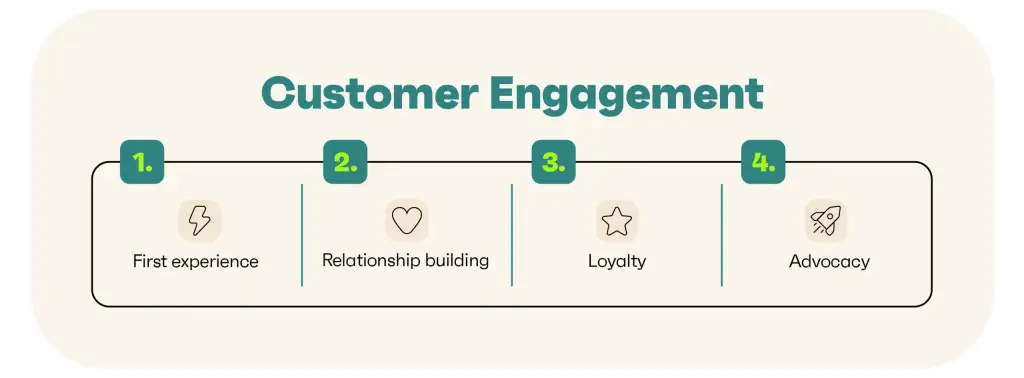
What is customer engagement marketing?
Customer engagement marketing refers to the methods that brands use to connect with their customers effectively through various channels and touchpoints. It’s a way to build relationships with customers to increase loyalty and sales.
Using customer engagement strategies, processes, and technologies, businesses can reach customers in different ways. From email campaigns and social media posts to SMS marketing and personalized messages, you can use a variety of tactics to increase customer engagement.
The image below illustrates the four stages of customer engagement marketing with indications of the corresponding tasks involved in each phase.

Customer engagement marketing examples
The most common examples of customer engagement marketing are:
- Email signup popup
- Welcome email
- Product update
- Birthday email
- Loyalty program update
1. Email signup popup
An email signup popup is an effective way for businesses to quickly engage website visitors and convert them into customers. The popup displays a form that allows customers to sign up for emails, which will allow businesses to stay in touch with them through relevant offers and updates.
A typical email signup popup looks like the following example from Organic Aromas. See how it includes incentives for customers to join, such as discounts or exclusive offers. Organic Aromas saw a 150% increase in their email building after implementing this email sign-up popup on their website.
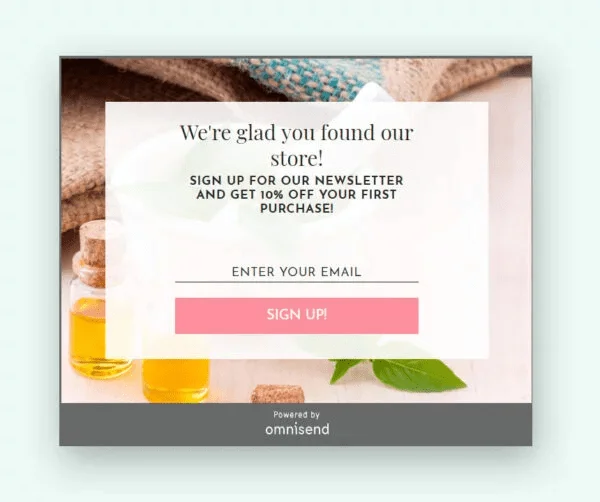
2. Welcome email
A welcome email is a good example of customer engagement marketing because it is a way for businesses to connect with customers and show appreciation. They’re also an excellent way for businesses to introduce customers to their brand, goals, objectives, and methodology.
With a welcome email, you can introduce yourself in a way that resonates with customers and makes them feel like part of something bigger. This is important for building relationships with customers over time and increasing loyalty towards your business.
Take Ta’ok Chocolate for example. In their welcome email, the co-founder, Jerry Toth, shared his story about how he created the chocolate brand. After being obsessed with cacao farming, he single-handedly made chocolate without any machinery, in the middle of a forest. A couple of years later, additional colleagues teamed up with him to establish a company. This type of storytelling helps customers get to know about a brand and creates a connection with them.
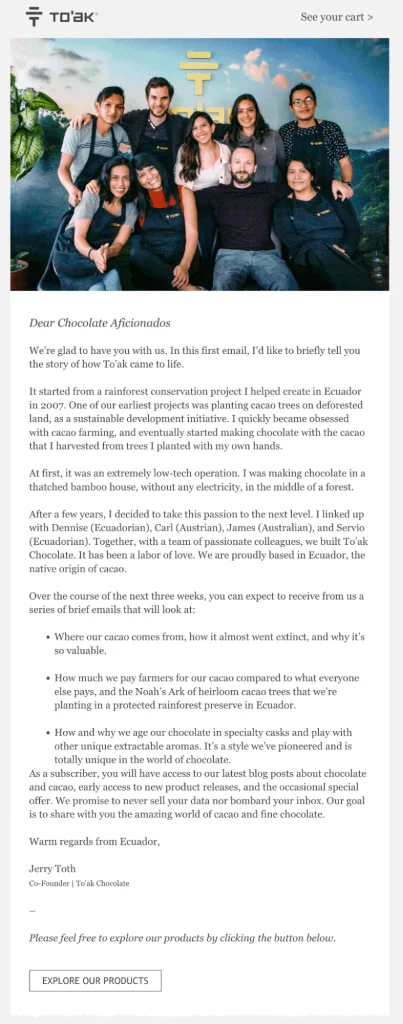
“We had an aha moment when we recognized that email could be a powerful tool for engaging customers…”
James Le Compte, CEO at To’ak Chocolate, explains why email is at the front and center of their customer engagement strategy:
👉 How To’ak Chocolate engages customers with emails
3. Product update
Sending regular product updates to customers is an effective way to involve them and keep them informed about your business’s activities. They offer an easy way for businesses to notify their customers about new products, features, or updates to existing ones. It’s also a great way to build relationships by showing customers that you value their opinion and feedback.
For example, Omnisend sent out an email to customers named “What’s new” and it included an update about a new email builder feature. It also described features that are available with the new builder, which made customers excited to try it out.
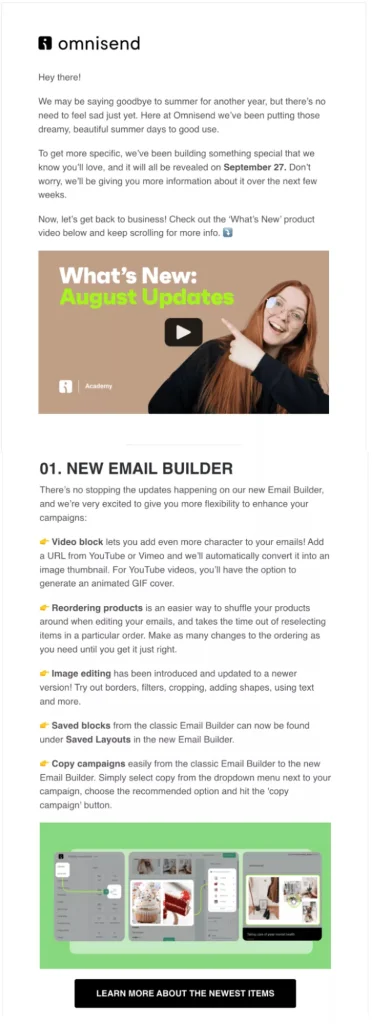
4. Birthday email
One way to show your appreciation for your customers’ loyalty is by sending them a birthday email. You can also use the birthday email as an opportunity to surprise customers with exclusive offers or discounts on their special day. Usually, birthday emails generate 179% more clicks, 481% more transactions, and 342% more revenue per email.
For instance, Nine Lives Bazaar sent out a birthday email to their customers offering them a $25 voucher to treat themselves on their birthday, valid for three days only. This email was extremely successful and increased sales as customers were more inclined to shop from the Nine Lives Bazaar to take advantage of the voucher.
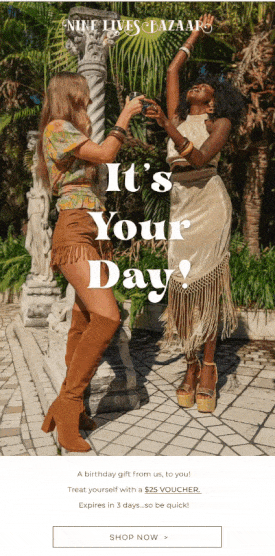
5. Loyalty program update
A loyalty program update is a great way to engage customers and keep them updated about the progress they’re making in your loyalty program. It motivates customers to continue making purchases with your store by giving them a chance to win rewards and discounts.
Take Holo Taco for example. The nail art brand has a loyalty program where customers can collect points when they make purchases. By visiting the loyalty page on their website, customers can redeem their points for rewards and cash them in for discounts or free products. This encourages customers to keep buying from Holo Taco and helps to build loyalty.
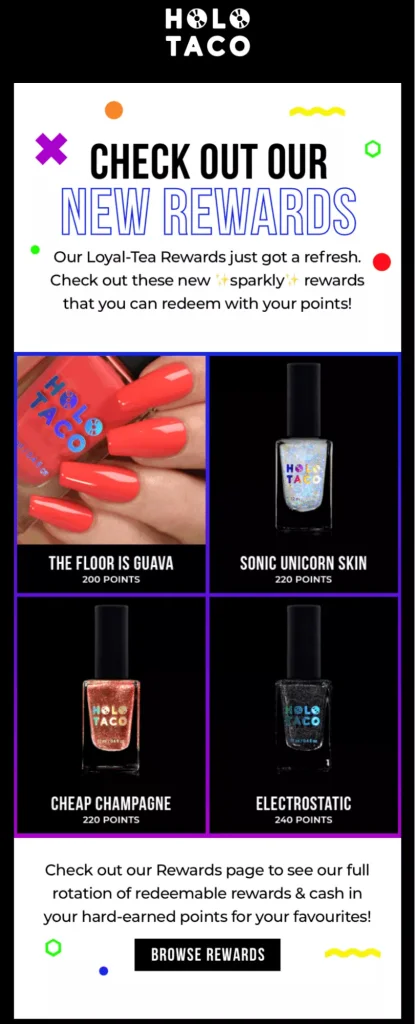
How to develop a customer engagement marketing strategy
Customer engagement marketing can be an effective way to strengthen relationships with customers and increase loyalty towards your business. To get the most out of this strategy, follow these steps:
- Plan your strategy
- Map the experience of customers
- Create marketing content
- Use marketing apps
- Review your strategy
1. Plan your strategy
Planning is the first step in developing a successful customer engagement marketing strategy. Before preparing your strategy, you need to identify your goals, understand customer needs and preferences, analyze customer data, and research the competition.
Customer research
When starting to plan your customer engagement marketing strategy, it’s important to know who you are targeting and what their needs and preferences are. Understanding your customers is the key to creating an effective customer engagement marketing strategy.
Not only do you need to know who your customers are, but you also need to know why they buy from you. What makes them keep coming back? Do they like special offers or discounts? Researching the answers to these questions will help you tailor your strategy and create content that resonates with customers.
Channel planning
Once you have identified your target audience and their needs, it’s important to work out the channels you will use to reach them. Email marketing, social media, and SMS are some of the most popular channels for customer engagement campaigns, but there are plenty of other options available to you.
Different audiences use different social channels and platforms, so it’s important to select those that are most likely to engage with your content. For example, if your target audience is aged 25-35, they are likely to be on Instagram and Facebook. If they’re older, they might prefer email newsletters or direct mail.
The success of your customer engagement strategy depends on the resources you have at your disposal. You need to have a team in place with the right skills and knowledge to execute your strategy effectively. You also need to plan how much time and money you can invest in the strategy.
Many companies use customer engagement software to streamline their efforts and manage customer data and communication. These software solutions can be a great way to increase efficiency, automate processes, and get more out of your customer engagement efforts.
Goal setting
Once you have planned your strategy and identified the resources you need, it’s time to set your goals. Depending on what you are hoping to achieve with your customer engagement marketing efforts, you might set goals such as increasing customer retention, boosting sales, or driving website traffic.
Your goals should be SMART: Specific, Measurable, Achievable, Relevant, and Timely. This will track your progress and measure the success of your strategy.
2. Map the experience of your customers
Mapping the customer experience can help you identify the touchpoints where customers engage with your business and understand what drives their decisions. This will create a cohesive customer experience and ensure that customers have a positive interaction with your brand.
To set up an effective customer engagement strategy, here are some steps you can take:
- Define communication touchpoints:
Identify the channels customers can use to communicate with your business, such as email, website chat, social media, and phone calls. - List customers’ goals and needs at each touchpoint:
Understand what customers are looking for at each touchpoint and how you can help. - Choose marketing channels to use:
Select the channels that are most suitable for reaching your target audience.
The image displays a simple customer journey that does not include any marketing channels.
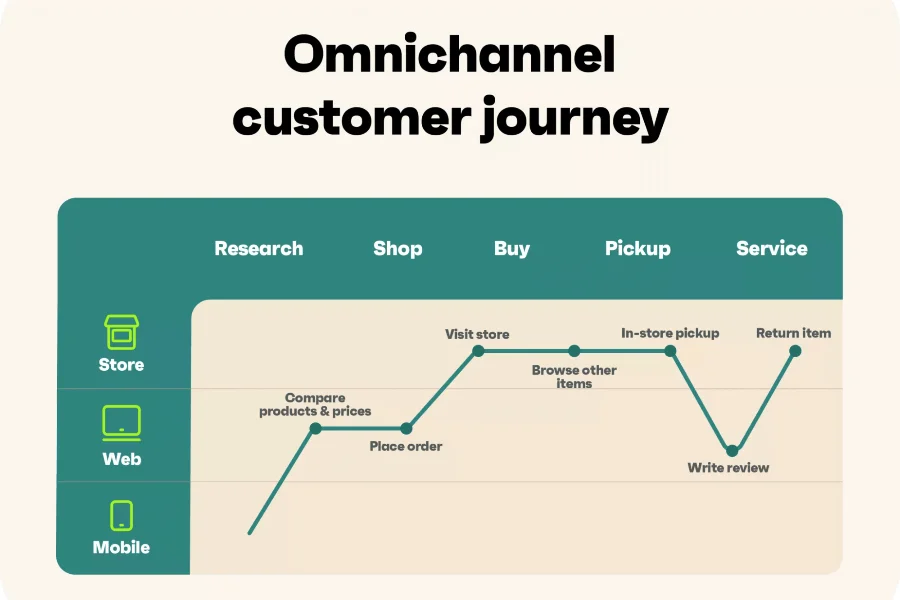
3. Create marketing content
Once you have identified the channels and touchpoints your customers use, it’s time to make content for the marketing channels. Content should be useful and relevant for customers, so it’s important to understand their needs and preferences, such as helpful blog posts or informative videos.
Example — Email strategy content:
- Welcome email
The welcome email is the perfect opportunity to introduce your customers to your brand, thank them for signing up, or offer a discount. - Newsletter email
Use newsletters to keep customers up-to-date with the latest news, product descriptions, discounts, and promotions. - Sale announcement email
Announce sales or discounts to get customers excited and encourage them to make a purchase. - Birthday greetings email
Send customers a personalized message on their birthday to show you care and increase customer loyalty. - Cart recovery email (automatic)
Use automation to send customers a reminder when they have left items in their cart without completing the purchase. - Product abandonment email
Send customers an email when they leave a product page without buying the product.
To improve consumer engagement, consider refining your content based on customer feedback and performance data. This will help you adjust your strategy to meet customers’ changing needs and preferences.
An image showing how to greet customers using more than one channel.

4. Use marketing apps
A great way to enhance customer engagement is to use marketing apps. You can use these apps for multiple purposes, such as collecting data on customers’ behavior, testing campaigns to maximize their effectiveness, and automating customer engagement tasks. It can make communication with customers easier and improve customer experience.
Consider these apps:
- Omnisend (emails + popups + push notifications)
This app helps engage customers with personalized emails, messages, and push notifications. By using automated campaigns, the app can increase conversions and sales. - HubSpot (CRM)
This app provides customer relationship management (CRM) capabilities by storing and managing customer data, automating marketing and sales tasks, tracking customer engagement, and producing customer insights. - Tidio (live chat)
With Tidio’s live chat, you can send targeted messages and offers to customers, track conversations, and solve inquiries instantly to build trust. - Smile.io (loyalty program)
Tailored to your business, this app helps you create loyalty programs with points rewards, discounts, and referral campaigns. It enables customers to earn rewards and feel valued each time they purchase from your business. - Typeform (surveys)
Use this app to get instant feedback from customers about their experience with your business. With surveys, you can understand customers’ needs and design more effective marketing campaigns.
5. Review your customer engagement marketing strategy
It’s crucial to regularly review your customer engagement marketing strategy to ensure it’s up-to-date and effective. Analyze customer data and track the performance of each campaign to identify what’s working and what isn’t. You can also use feedback from customers to make improvements to your campaigns.
It’s crucial to track the right metrics too. Open rates, click-through rates, and conversions are all important metrics that can help you measure the success of your customer engagement marketing strategy. You should also look at the number of active customers, customer lifetime value (CLV), and overall engagement rate.
By monitoring these metrics regularly, you can adjust your campaigns where necessary and make sure that your strategy is meeting its goals.
Customer engagement marketing: Summary
Customer engagement is the key to increasing brand loyalty and long-term customer retention. By developing a strong customer engagement strategy, businesses can significantly increase their customer base and build on those relationships for the future. With the right combination of customer segmentation, tailored communication, personalized messages, and rewarding activities, you can create an unbeatable customer experience.
Whether it’s an interactive quiz or a special bundle discount code sent out by email or SMS – you have plenty of options for resolving your customer’s needs to engaging them in meaningful conversations.
Don’t forget to try Omnisend–it’s one of the leading platforms offering automated campaigns and incredible customization options for any type of business.
Source from Omnisend
Disclaimer: The information set forth above is provided by Omnisend independently of Alibaba.com. Alibaba.com makes no representation and warranties as to the quality and reliability of the seller and products.
